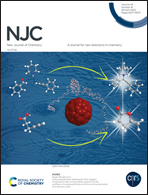An anthracene-pendant ruthenium(ii) complex conjugated to a biotin anchor, an essential handle for photo-induced anti-cancer activity†
Abstract
The development of new medical therapies has greatly advanced, and phototherapy has shown major potential. Ruthenium complexes have showed promising phototherapeutical applications, particularly against cancer. Despite that, cell selectivity and uptake seem to be one bottleneck issue for those compounds. Biotin has been used as an anchor to provide drug selectivity to certain cancer cells, which overexpressed biotin receptors. This approach was taken here to modify a previously reported anthracene- and dppz-based ruthenium(II) compound (Ru-anth), which exhibited strong DNA binding and high singlet oxygen photoproduction. This new biotinylated compound (Ru-biot) was characterized and its chemical, biochemical and biological properties investigated. Indeed, the biotin linker did not significantly alter the DNA binding affinity (Kb = 6 × 106) of this compound, neither its singlet oxygen photoproduction (blue light, ΦΔ = 0.75), allowing further investigations. Notably, this new compound showed also great 1O2 production with green (ΦΔ = 0.51) and red (ΦΔ = 0.19) light. Biological studies showed antimicrobial activity against S. aureus with MIC of 14 μmol L−1. Interestingly, neither the non-biotinylated nor the biotinylated ruthenium compounds showed any cytotoxicity against human cancer or healthy cell lines in the dark. However, upon light irradiation, we observed very selective cytotoxicity only of the biotinylated compound against only A549 and MCF7 cancer cells, well-known to overexpress biotin receptors. Altogether, these results showed that a suitable combination of ligands and proper selection of handles can provide a ruthenium compound with multiple essential functionalities, such as selectivity (cancer), biological target specificity (DNA) and enhanced controllable generation of toxic cargos (1O2), making a promising agent for phototherapy.



 Please wait while we load your content...
Please wait while we load your content...